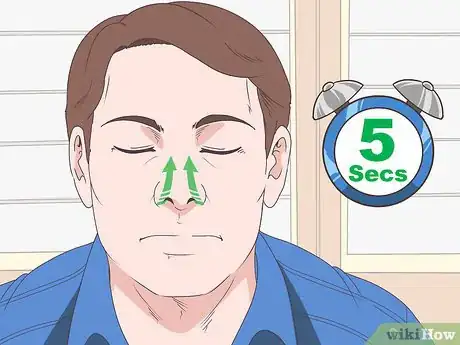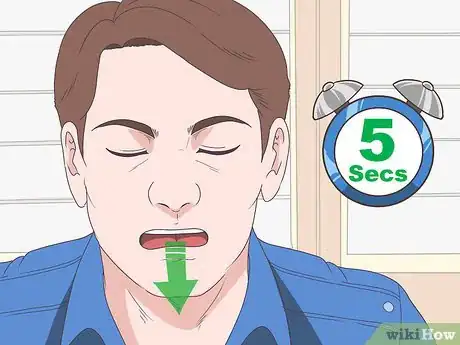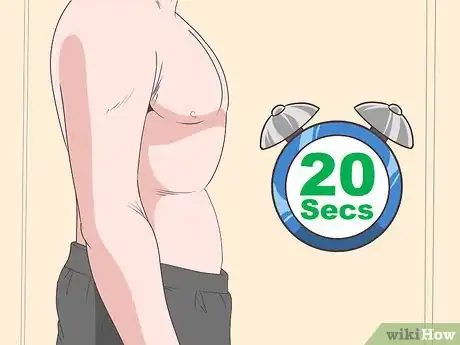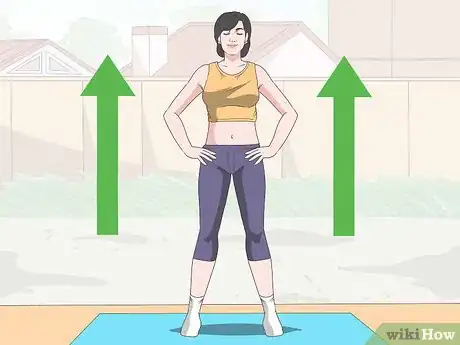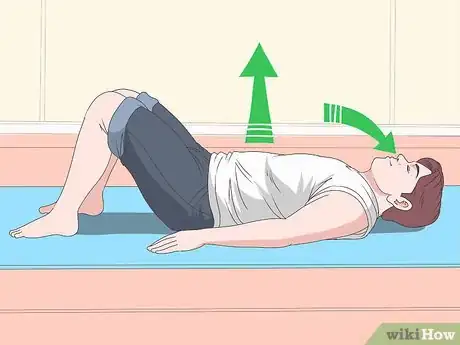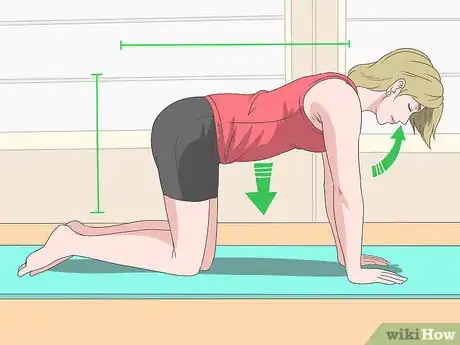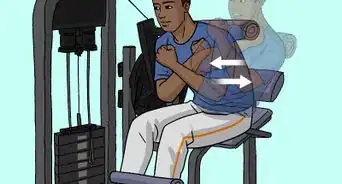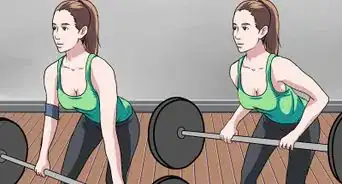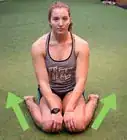This article was co-authored by Patricia Ladis PT, CBBA. Patricia Ladis PT, CBBA is a Licensed Physical Therapist and the Founder of WiseBody Physical Therapy out of New York, NY. With over 22 years of experience, Patricia specializes in providing a collaborative and holistic approach to pain, including nerve and chronic pain, injury prevention, and prenatal/postpartum wellness. She holds a BS in Physical Therapy from New York University. Patricia is a Certified Behavioral Breathing Analyst (CBBA) and holds certifications in Kinetic Control’s Performance Matrix Assessment Screen and the Integrative Systems Model. She co-founded First 1000 Days of Wellness, an educational platform for practitioners and the public to improve perinatal wellness. Patricia has been featured in Forbes, Vogue, and Men’s Health and has made television appearances on NBC and CBS.
There are 12 references cited in this article, which can be found at the bottom of the page.
This article has been viewed 534,440 times.
The stomach vacuum exercise is a great way to strengthen your abs, helping to improve your posture while also protecting your inner organs. You can do this exercise from almost any position, including standing, sitting, and kneeling. Just exhale all of the air in your body while pulling in your stomach to perform the exercise. Make sure to hold this position for at least 5 seconds.
Steps
Performing the Exercise
-
1Start by standing up straight with your feet shoulder-width apart. There are lots of ways you can position yourself for this exercise, but standing up straight is a simple way to begin. Keep your back straight and your shoulders back so that you're not slumping, but avoid standing in a way that's uncomfortable.[1]
- You can also do this exercise on your back, on your stomach, sitting down, or kneeling.[2]
-
2Breathe in through your nose slowly. Take a deep breath in, filling your lungs up with air. Go slowly, breathing in for roughly 3-5 seconds.[3]
- If your nose is congested, breathe in slowly through your mouth.
Advertisement -
3Exhale through your mouth so there’s no air left in your lungs. Exhale slowly as you pull your stomach muscles inward and hold until you are ready to inhale again. Then, relax your muscles. It’s super important that you let out the air through your mouth instead of your nose, since this gives you more control over your breathing. Exhale slowly until there isn’t any air left in your body.[4]
- It may help you to try to exhale all of the air in roughly 3-5 seconds as well, helping time your breathing.
- You're able to get rid of more air in your body by exhaling through your mouth.
- You may also want to add a pelvic floor lift as you contract your abdominal muscles.
-
4Suck in your belly button as far as possible. While you are exhaling, suck in your stomach as far as it will go. To visualize what your stomach should look like, picture flattening your belly button against your backbone.[5] [6]
- If you can’t suck your stomach in very far, that’s okay! This step takes practice and will improve over time.
-
5Hold this position for roughly 20 seconds if you are going to continue inhales and exhales. If you’re just learning this exercise, you may only be able to hold it for 5-10 seconds. It is important to continue breathing normally during the exercise, so don’t hold your breath.[7]
- Practicing this exercise regularly will help you increase the amount of time you can hold in your breath and stomach, eventually reaching as long as 60 seconds.
- Some people hold their breath the entire time they’re holding the position, while others try to breathe normally. Do not relax your stomach muscles.
-
6Breathe in while releasing your stomach to repeat the process. Relax your muscles and take a nice breath in. Relax your stomach back to its original position, and allow it to expand as your lungs fill with air. Start over again with another stomach vacuum as you exhale and suck in your stomach.[8]
- Make sure to breathe normally throughout this exercise.
- Remember to do this slowly and carefully, monitoring your breathing.
-
7Do this exercise 5 times before taking a break. People with more experience doing this exercise may do it 10 times before stopping, but start off with 5 times. Breathe in deeply and exhale deeply each time, counting the seconds of how long you’re able to hold in your stomach.[9]
- You may need to break up the stomach vacuums, doing 2 and then taking a 1- or 2-minute break before doing another 3.
Choosing a Position
-
1Exercise standing up to ensure you have the right posture. Stand with your feet shoulder-width apart, making sure they’re both flat on the ground. Keep your back straight as you’re breathing in.[10]
- You can do this while standing in line at the store or while cooking in the kitchen.
-
2Do stomach vacuum exercises sitting down for convenience. If you’re in the car or sitting at work, you can still do these exercises to strengthen your body. Sit up straight in your chair and place your hands beside your thighs (if possible). Relax your shoulders, keep them down and pulled back slightly. Begin breathing in slowly and exhaling all of the air in your lungs before sucking in your stomach and holding the position.[11]
- When you’re sitting down, it’s especially important that you have great posture while doing this exercise.
-
3Lie down on your back for controlled stomach vacuum exercises. With your back flat on the ground, bend your knees and place your feet flat on the ground as well. Place your hands on either side of you and start the deep breathing to begin the exercise.[12]
- There isn’t a certain spot where your feet need to be - as long as your body is comfortable on the ground, you’re in the right position.
- You may also round your body forward slightly to make this exercise more effective.
-
4Kneel on the ground for a stable exercising position. Place your hands with your palms flat on the ground right below your shoulders. Your knees are on the ground as well so that your legs make a 90 degree angle with the floor. Bend your feet so that your toes are on the ground and your heels are off of the ground. Breathe deeply and suck in your stomach while holding this position.[13]
- Look down towards your hands as you hold this position.
- Try not to arch your back.
Expert Q&A
-
QuestionDoes the stomach vacuum exercise really work?
 Patricia Ladis PT, CBBAPatricia Ladis PT, CBBA is a Licensed Physical Therapist and the Founder of WiseBody Physical Therapy out of New York, NY. With over 22 years of experience, Patricia specializes in providing a collaborative and holistic approach to pain, including nerve and chronic pain, injury prevention, and prenatal/postpartum wellness. She holds a BS in Physical Therapy from New York University. Patricia is a Certified Behavioral Breathing Analyst (CBBA) and holds certifications in Kinetic Control’s Performance Matrix Assessment Screen and the Integrative Systems Model. She co-founded First 1000 Days of Wellness, an educational platform for practitioners and the public to improve perinatal wellness. Patricia has been featured in Forbes, Vogue, and Men’s Health and has made television appearances on NBC and CBS.
Patricia Ladis PT, CBBAPatricia Ladis PT, CBBA is a Licensed Physical Therapist and the Founder of WiseBody Physical Therapy out of New York, NY. With over 22 years of experience, Patricia specializes in providing a collaborative and holistic approach to pain, including nerve and chronic pain, injury prevention, and prenatal/postpartum wellness. She holds a BS in Physical Therapy from New York University. Patricia is a Certified Behavioral Breathing Analyst (CBBA) and holds certifications in Kinetic Control’s Performance Matrix Assessment Screen and the Integrative Systems Model. She co-founded First 1000 Days of Wellness, an educational platform for practitioners and the public to improve perinatal wellness. Patricia has been featured in Forbes, Vogue, and Men’s Health and has made television appearances on NBC and CBS.
Licensed Physical Therapist Yes, although you need to make sure that you're breathing from your diaphragm. It's really essential. If you don't, you're really not going to see a ton of benefits.
Yes, although you need to make sure that you're breathing from your diaphragm. It's really essential. If you don't, you're really not going to see a ton of benefits. -
QuestionI feel like I'm doing this wrong. Are there any tricks to getting better at this?
 Patricia Ladis PT, CBBAPatricia Ladis PT, CBBA is a Licensed Physical Therapist and the Founder of WiseBody Physical Therapy out of New York, NY. With over 22 years of experience, Patricia specializes in providing a collaborative and holistic approach to pain, including nerve and chronic pain, injury prevention, and prenatal/postpartum wellness. She holds a BS in Physical Therapy from New York University. Patricia is a Certified Behavioral Breathing Analyst (CBBA) and holds certifications in Kinetic Control’s Performance Matrix Assessment Screen and the Integrative Systems Model. She co-founded First 1000 Days of Wellness, an educational platform for practitioners and the public to improve perinatal wellness. Patricia has been featured in Forbes, Vogue, and Men’s Health and has made television appearances on NBC and CBS.
Patricia Ladis PT, CBBAPatricia Ladis PT, CBBA is a Licensed Physical Therapist and the Founder of WiseBody Physical Therapy out of New York, NY. With over 22 years of experience, Patricia specializes in providing a collaborative and holistic approach to pain, including nerve and chronic pain, injury prevention, and prenatal/postpartum wellness. She holds a BS in Physical Therapy from New York University. Patricia is a Certified Behavioral Breathing Analyst (CBBA) and holds certifications in Kinetic Control’s Performance Matrix Assessment Screen and the Integrative Systems Model. She co-founded First 1000 Days of Wellness, an educational platform for practitioners and the public to improve perinatal wellness. Patricia has been featured in Forbes, Vogue, and Men’s Health and has made television appearances on NBC and CBS.
Licensed Physical Therapist Yes! It can definitely be a little tricky. I think it often helps to picture it as a kind of single motion. Imagine yourself drawing in the skin just above your pubic bone. Then, pull your stomach in at an upward angle towards your spine. Once you feel the deepest part of your core engaged, you've got it!
Yes! It can definitely be a little tricky. I think it often helps to picture it as a kind of single motion. Imagine yourself drawing in the skin just above your pubic bone. Then, pull your stomach in at an upward angle towards your spine. Once you feel the deepest part of your core engaged, you've got it! -
QuestionWhat muscle is being worked here?
 Patricia Ladis PT, CBBAPatricia Ladis PT, CBBA is a Licensed Physical Therapist and the Founder of WiseBody Physical Therapy out of New York, NY. With over 22 years of experience, Patricia specializes in providing a collaborative and holistic approach to pain, including nerve and chronic pain, injury prevention, and prenatal/postpartum wellness. She holds a BS in Physical Therapy from New York University. Patricia is a Certified Behavioral Breathing Analyst (CBBA) and holds certifications in Kinetic Control’s Performance Matrix Assessment Screen and the Integrative Systems Model. She co-founded First 1000 Days of Wellness, an educational platform for practitioners and the public to improve perinatal wellness. Patricia has been featured in Forbes, Vogue, and Men’s Health and has made television appearances on NBC and CBS.
Patricia Ladis PT, CBBAPatricia Ladis PT, CBBA is a Licensed Physical Therapist and the Founder of WiseBody Physical Therapy out of New York, NY. With over 22 years of experience, Patricia specializes in providing a collaborative and holistic approach to pain, including nerve and chronic pain, injury prevention, and prenatal/postpartum wellness. She holds a BS in Physical Therapy from New York University. Patricia is a Certified Behavioral Breathing Analyst (CBBA) and holds certifications in Kinetic Control’s Performance Matrix Assessment Screen and the Integrative Systems Model. She co-founded First 1000 Days of Wellness, an educational platform for practitioners and the public to improve perinatal wellness. Patricia has been featured in Forbes, Vogue, and Men’s Health and has made television appearances on NBC and CBS.
Licensed Physical Therapist The transversus abdominus, which is the deepest muscle in your core. This exercise is popular because it's usually really hard to exercise that part of your body.
The transversus abdominus, which is the deepest muscle in your core. This exercise is popular because it's usually really hard to exercise that part of your body.
References
- ↑ https://www.yahoo.com/lifestyle/stomach-vacuuming-easiest-way-to-flat-abs-or-too-124015211072.html
- ↑ https://www.yahoo.com/lifestyle/stomach-vacuuming-easiest-way-to-flat-abs-or-too-124015211072.html
- ↑ https://www.youtube.com/watch?v=f2PliOQHQ4c#t=9s
- ↑ https://www.youtube.com/watch?v=N9msEniBkbU#t=1m8s
- ↑ https://www.youtube.com/watch?v=f2PliOQHQ4c#t=11s
- ↑ Patricia Ladis PT, CBBA. Licensed Physical Therapist. Expert Interview. 19 March 2021.
- ↑ https://www.youtube.com/watch?v=f2PliOQHQ4c#t=15s
- ↑ https://www.youtube.com/watch?v=f2PliOQHQ4c#t=27s
- ↑ https://news.yahoo.com/ab-exercise-called-stomach-vacuum-164749376.html
About This Article
The stomach vacuum exercise is a great way to strengthen your abs and help improve your posture To do the stomach vacuum exercise, first stand up straight and breathe in through your nose for 5 seconds. Then, slowly exhale through your mouth for 5 seconds while sucking your belly button in as far as it will go. Hold your stomach in for at least 20 seconds. While you contract and suck your stomach in, continue breathing. After 20 seconds, release your stomach muscles and allow your belly to expand. That counts as 1 rep. Do 5 reps per workout. Over time, work your way up to holding your stomach in for 60 seconds per rep. You can do the stomach vacuum exercise in a variety of other positions too, like sitting in a chair, lying down, or while doing a plank. For more tips from our Personal Training co-author, including how to do the stomach vacuum exercise sitting or lying down, read on!

